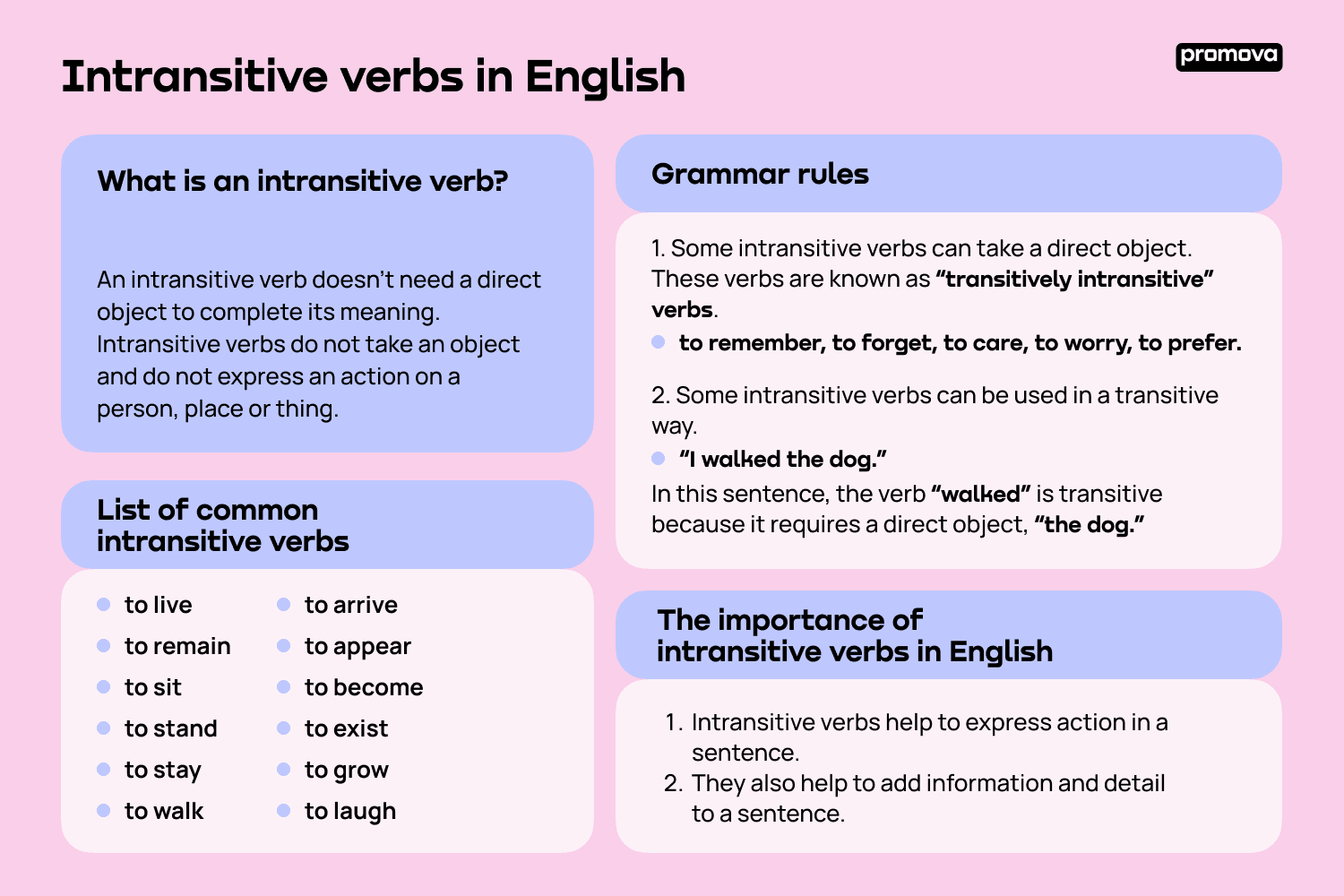Intransitive verbs in English
Contents
Do you often find yourself struggling to understand the difference between transitive and intransitive verbs? It's not an easy subject for many learners to get the first time around!
In this reference, we’ll be exploring the concept of intransitive verbs in English and how to use them in a sentence.
What is an intransitive verb?
An intransitive verb doesn't need a direct object to complete its meaning. In other words, it is a verb that is not “transitive”. Intransitive verbs do not take an object and do not express an action on a person, place or thing. An intransitive verb is not an action verb, but it is still an important part of English grammar.
The most common type of intransitive verb is an auxiliary verb. Auxiliary verbs are used to form tenses and moods and to help express the meaning of a sentence. Examples of auxiliary verbs include can, could, have, has, and will.
Other types of intransitive verbs include linking verbs, such as to be, to become, and to seem. Linking verbs help us connect the subject of a sentence to a phrase or clause that modifies or describes it.
Still other intransitive verbs include verbs of perception, such as to look, to feel, to smell, or to taste. Verbs of perception are used to describe how the subject of a sentence perceives the object. 
What is the difference between transitive and intransitive verbs?
Transitive verbs need a direct object to complete their meaning, while intransitive verbs do not.
Transitive verbs indicate an action that is done to a person, place, thing, or idea. For example, in the sentence “I ate the apple,” the verb “ate” is transitive because it requires a direct object, “the apple.”
On the other hand, intransitive verbs typically describe a state of being, an action that is not done to an object, or a movement. For example, in the sentence “I sneezed,” the verb “sneezed” is intransitive because it does not require a direct object.
The importance of intransitive verbs in English
Intransitive verbs are an important part of English grammar because they help to express action in a sentence. For example, in the sentence “He walks to school,” the verb “walks” is intransitive because it does not require a direct object. Without the intransitive verb “walks,” the sentence would not make sense.
Intransitive verbs also help to add information and detail to a sentence. For example, in the sentence “He walked slowly to school,” the verb “walked” is still intransitive, but the adverb “slowly” adds more information about how the subject is performing the action.
2
Intransitive verbs grammar rules
As with most grammar rules, there are some exceptions to the rule of intransitive verbs. For example, some intransitive verbs can take a direct object. These verbs are known as “transitively intransitive” verbs. Examples of transitively intransitive verbs include to remember, to forget, to care, to worry, and to prefer.
In a sentence, transitively intransitive verbs will look like this:
“I remembered the lyrics.” In this sentence, the verb “remembered” is intransitive, but it still requires a direct object, “the lyrics.”
In addition, some intransitive verbs can be used in a transitive way.
For example, the verb “walk” can be used transitively in the sentence “I walked the dog.” In this sentence, the verb “walked” is transitive because it requires a direct object, “the dog.”
Intransitive verb examples sentences
To better understand intransitive verbs, let’s look at some example sentences.
“He smiled.”
In this sentence, the verb “smiled” is intransitive because it does not require a direct object.
“She ran quickly.”
In this sentence, the verb “ran” is intransitive because it does not require a direct object, but the adverb “quickly” adds more information about how the subject is performing the action.
“They laughed loudly.”
In this sentence, the verb “laughed” is intransitive because it does not require a direct object, but the adverb “loudly” adds more information about how the subject is performing the action.
Let's try a more complex sentence:
"She jumped joyfully over the fence."
In this sentence, the verb "jumped" is intransitive because it does not require a direct object, but the adverb "joyfully" adds more information about how the subject is performing the action. The phrase "over the fence" adds more detail to this sentence and helps to create a vivid image in our minds.
7
List of common intransitive verbs
Now that you know what an intransitive verb is and how to use it in a sentence, let’s take a look at some common intransitive verbs.
- to arrive
- to appear
- to become
- to exist
- to grow
- to laugh
- to live
- to remain
- to sit
- to stand
- to stay
- to walk
Summary
Intransitive verbs can sound confusing, but all the idea means is that they don't require an object. Armed with the examples from earlier, you should easily form sentences with intransitives and create powerful sentences.
Don't forget to check below for more handy learning resources!
Comments